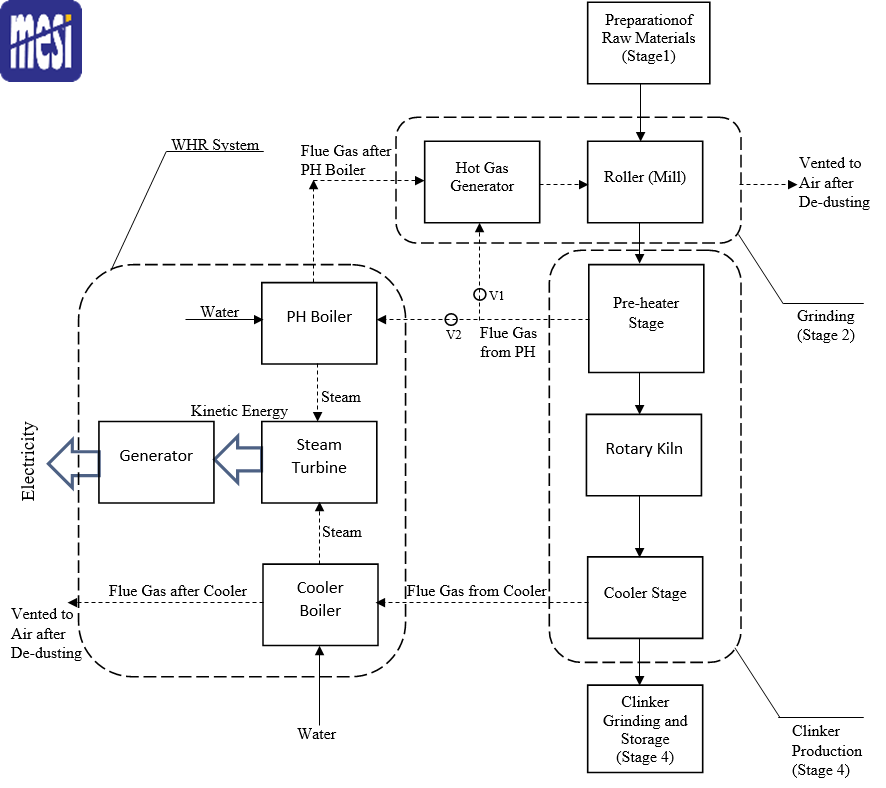The Effect of Excess Heat Utilization on the Production Cost of Cement
Main Article Content
Abstract
Industrial excess heat is a largely untapped resource that has the potential for external use that would be beneficial to the cement industry. Therefore, this work studied the excess heat utilization for the optimization of production cost in a cement plant within a period of three years. The study of plant layout in the selected plant in Nigeria (Ewekoro II Cement Plant of 200 tonnes/hour) was carried out to identify areas where excess heat is generated. The temperature and static pressure of precalciner, kiln, and cyclone were taken using a temperature probe, pitot tube, digital manometer, and light-emitting diode temperature reader. These parameters were used to obtain the mass flow rate and heat transfer needed for the heat energy analysis of the system. The kiln was maintained at constant tonnage per hour through a clinker truck weighed using the weighbridge. The result showed that the heat generated from the kiln was 577,640,260 MJ/hr. through excess air draft of 780,000 m3/hr (89.4%) at 250 °C and induced draft fan of 900,000 m3/hr at 350 °C. The result showed that excess heat can be utilized in pre-heater and air quenched cooler boilers, steam turbines and auxiliaries, and generators. The total estimated heat that could be saved amounted to 344,648,250 MJ with a total annual capacity of 2.25 million tonnes of cement. A saving of over two billion dollars could be achieved in production cost per year.
Downloads
Article Details

This work is licensed under a Creative Commons Attribution-NonCommercial 4.0 International License.
References
[2] A. M. Radwan, ``Different possible ways for saving energy in the cement production``, Advances in Applied Science Research, vol.3, no.2, pp. 1162-1174,2012.
[3] V. S. Broberg and M. T. Johansson, ``Technologies for utilization of industrial excess heat: Potentials for energy recovery and CO2 emission reduction``, Energy Conversion and Management, vol. 77,pp. 369-379,2014.
[4] A. C. Caputo, P. M. Pelagagge, and P. Salini, “Performance modeling of radiant heat recovery exchangers for rotary kilns,” Appl. Therm. Eng., vol. 31, no. 14–15, pp. 2578–2589, 2011.
[5] O. R. Adetunji, S. M. Owolabi, O. M. Adesusi, O. U. Dairo, S. O. Ipadeola and S. O. Taiwo,``Effect of Computerized Maintenance Management System on a Cement Production Plant``, International Journal of Integrated Engineering, vol.10 no.4, pp. 12-16, Published by University of Technology, Malaysia; doi: https://doi.org/10.30880/ijie,2018.
[6] A. C. Caputo, P. M. Pelagagge, and P. Salini ``Performance modeling of radiant heat recovery exchangers for rotary kilns``, Applied Thermal Engineering, vol.31, pp 2578, 2011.
[7] M. Bollinger, E. Gallestey, G. Crosley, M. Kiener, ``Energy optimization in cement manufacturing``, 2007.
[8] C. D. Lawrence ``The production of low energy cements``, In: Hewlett PC, Editor. Lea‘s Chemistry of Cement and Concrete, 4th Ed., London: Arnold, pp.421-470,2004.
[9] F. Gronwall and R. Khodabandeh ``Effective Use of Excess Heat in a Cement Plant``; Master of Science Thesis,2012.
[10] S. B. Viklundand and M. Johanson ``Technologies for utilization of industrial excess heat: potentials for energy recovery and CO2 emission reduction``, Energy conversion and Management, vol. 77,pp. 369-379,2013.
[11] M. Schneider, M. Romer, M. Tschudin, and H. Bolio, ``Sustainable cement production—present and future``. Cement and Concrete Research, vol. 41 no.7, pp. 642–650,2011.
[12] H. W. Meyer and M. Lambert, ``Professional cement plant optimization, modernization and Energy conservation``,2014.
[13] S. Dienner, J. C. Reiser, M. Mbeguere, and L. Strande, ``Waste heat recovery from cement production for faecal sludge drying``, Eawag: Swiss Federal Institute of Aquatic Science and Technology, Dubendorf, Switzerland, 2012.
[14] International Financial Corporation of World Bank Annual Report, http://www.ifc.org/wps/wcm/connect/corp_ext_content/ifc_external_corporate_site/annual+report+14/2014_online_report/2014_printed_report
[15] F. Akgun, “Investigation of energy saving and NOX reduction possibilities in rotary kiln”, International Journal of Energy Research, vol.27 no.4, pp. 455-466,2003.
[16] M. Zandieh, M. R. Aligodarz, and A. Mehrparahi, ``Comparative Energy and Exergy Analysis for the Utilization of Alternative Fuels in the Cement Kiln``, Environmental Energy and Economic Research, vol.4, no.1, pp. 15-26,2020.
[17] A. Murray and L. Price, ``Use of Alternative Fuels in Cement Manufacture: Analysis of Fuel Characteristics and Feasibility for Use in the Chinese Cement Sector``, Ernest Orlando Lawrence Berkeley National Laboratory, 2008.
[18] U. Camdali, A. Erisen, and F. Celen, ``Energy and exergy analyses in a rotary burner with pre-calcinations in cement production``, Energy conversion and management, vol.45,pp. 3017-3031, 2004.
[19] P. R. Kousalya, K. Rajakarthikeyan, and B. Janani, ``Production Process of Cement in India``. International Journal of Scientific Research, vol. 3 no.11, pp. 70-71, 2014.
[20] O. R. Adetunji, D. T. Onawoga, O. O. Adegbesan, and O. U. Dairo, ``Modification of Steel-Roller Composition to Curb Excessive Wear``, Nature Journal of Failure Analysis and Prevention, vol.19 no.6,pp. 1655-1665, 2019.
[21] E. Tahsin and A. Vedat, ``Energy auditing and recovery for dry type cement rotary kiln systems – A case study``. Energy Conversion and Management, vol. 46 no.4, pp. 551-562, 2005.
[22] X. Sui, Y. Zhang, S. Shao, and S. Zhang, ``Exergetic life cycle assessment of cement production process with waste heat power generation``, Energy conversion and management, vol. 88, pp. 684-692, 2014.
[23] ABB in cement industry from quarry to dispatch, www.abb.com/cement accessed in 2015.
[24] Groupe Lafarge Quand les déchets deviennent ressources, Crescendo, pp. 20-25, 2007.
[25] A. A. Boateng, ``Rotary Kilns: Transport Phenomena and Transport Processes``, Burlington, United States of America: Butterworth-Heinemann Publication,2008.
[26] A. I. Barrett, ``How to reduce energy consumption``, World Cement, pp. 92-96, 2002..
[27] N. A. Madlool, R. Saidpur, M. S. Hossain, and N. A. Rahim, ``A critical review on energy use and savings in the cement industries``, Renewable and Sustainable Energy Reviews, vol. 15, 2042-2060, 2011.

